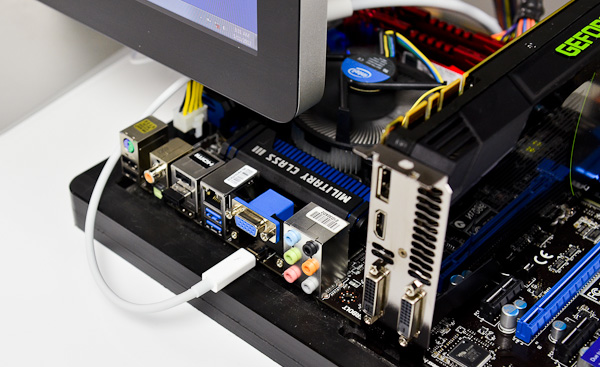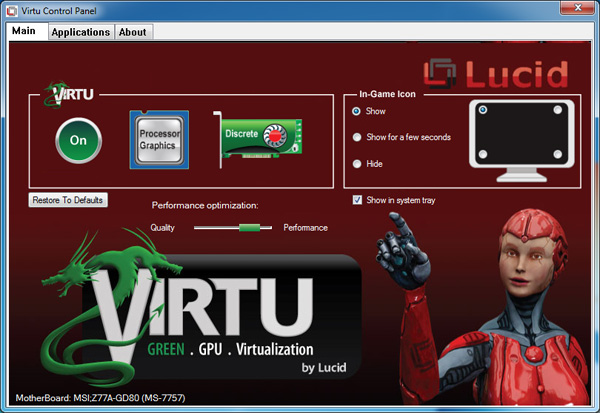A First Look at Thunderbolt on Windows with MSI's Z77A-GD80
by Anand Lal Shimpi on May 11, 2012 1:32 PM EST- Posted in
- Motherboards
- CPUs
- Intel
- MSI
- Thunderbolt
The Thunderbolt Display
The first test was hooking up Apple's Thunderbolt Display, the only Thunderbolt display device available on the market today. Although I shouldn't have been, I was a bit surprised when the display just worked. Intel's HD 4000 drove the 2560 x 1440 panel just fine and there weren't any funny issues displaying the lower res UEFI setup mode.
Despite Ivy Bridge being able to drive three independent displays, I was only able to simultaneously output to two connected displays on the GD80. All combinations of two worked however (TB + HDMI, TB + VGA, VGA + HDMI).
Once in Windows, the Thunderbolt Display's integrated GigE, Firewire and other controllers started popping up. Unfortunately Apple doesn't offer a direct download package for Thunderbolt Display drivers. You can either hunt down the controllers/drivers on their own, or you can build a Windows Support (driver) package using a Mac and the Boot Camp Assistant. I'd much rather Apple just offer an easy route for non-Mac Windows users to take advantage of the Thunderbolt Display as it's the only TB display on the market, but I can understand the lack of motivation there.
With the Boot Camp drivers installed, I got working GigE and Firewire 800. The Thunderbolt Display's integrated USB hub gave me issues however. Anything I plugged into it would either partially work (e.g. my mouse was detected but moving the cursor was far from smooth) or not work at all (e.g. my attached USB keyboard never worked). The other issue with the Thunderbolt Display is you get no brightness control, which can be a problem given how bright the panel gets. I've seen reports of people getting brightness control working via software tools but the solutions don't seem permanent.
Apple's Thunderbolt Display definitely works, but Windows users will likely want to wait for a Thunderbolt display that is built specifically with Windows in mind.
Virtu and Thunderbolt: It Works
From a software perspective, Thunderbolt is treated just like another display output driven by Intel's processor graphics. I installed a GeForce GTX 680 along with Lucid's Virtu GPU virtualization software to see if I could use the 680 for gaming but drive the display using Intel's processor graphics and the Thunderbolt port. The setup worked flawlessly.
Virtu recognized the configuration immediately once I had NVIDIA's drivers installed, and I was able to run the 680 headless - using only the Thunderbolt port to drive the external display. Intel's HD 4000 powered things in Windows, while the 680 kicked in for games.













98 Comments
View All Comments
DerPuppy - Friday, May 11, 2012 - link
lots of businesses might say the same about IE6...not helping your case lolExodite - Friday, May 11, 2012 - link
That's really not relevant.Any computer capable of running IE6 can run a more modern browser as well.
A VGA projector won't grow the digital connector of your choice through a firmware upgrade, however.
DerPuppy - Saturday, May 12, 2012 - link
you can have adapters just the same way you can have more modern browsersZoomer - Friday, May 11, 2012 - link
And you'll be carrying a desktop around to said offices using these vga ports for your presentations?MrPickins - Saturday, May 12, 2012 - link
As others have mentioned, DVI-I and DVI-to-VGA adapter would have worked for older displays.DerPuppy - Friday, May 11, 2012 - link
Question regarding requiring reboot upon adding thunderbolt devices. people have been adding external pcie devices via expresscard etc. (see: http://forum.notebookreview.com/e-gpu-external-gra... for forever. supposedly you can reconnect a disconnected egpu just by sleeping-> plugging-> waking a PC...would that work for thunderbolt?cjb110 - Friday, May 11, 2012 - link
Using thunderbolt you could put the slower advancing stuff into monitors (which also have stagnated at 1080p)So my gigabit network, large mechanical drives, wifi, bt etc is all in the monitor along with the usual periphery stuff connected printers, card readers etc.
My desktop then has the cpu/gpu and a much much simpler motherboard, no network, no need for lots of slow booting sata controllers, its the cpu, memory, gpu and a boot ssd.
A Alienware x51 type pc with a thunderbolt 1080 40/50" display would make a 'pc' console that would also be easy to maintain.
Zoomer - Friday, May 11, 2012 - link
Is that integration necessary? It seems like it'll be out of date soon. Would you want to replace your whole monitor just to get 11ac, or bt 3.0 lp?DerPuppy - Saturday, May 12, 2012 - link
well considering it's basically porting over PCIe...if you had mini PCIe connectors in your monitor you could "upgrade" your "dock", so to speakMetaluna - Friday, May 11, 2012 - link
It's good to see more Thunderbolt options showing up in the PC market, but it seems to me that a full-sized ATX motherboard that already has 7 PCIe slots is about the last place anyone would need TB.Totally unrelated topic: Is it just me or does anyone else find this whole "Military Grade" thing that has been showing up on motherboards lately to be one of the most embarassingly cheesy marketing gimmicks ever?